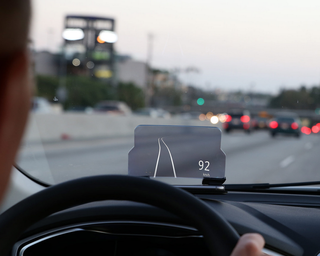Use Your Smartphone As a Heads-Up Display in Your Car
Keep your eyes on the road — and your nav, speedometer, and everything else — for less than $50.

If you want a heads-up display (HUD) to help you drive but aren't in the market for a brand-new vehicle, this new device might be for you: It's called the Hudway Glass, and it puts a smartphone-powered HUD on your dashboard for just $49.
Last week, Hudway launched a Kickstarter campaign for its Glass, which has a slightly curved, 5.9-inch-wide display that mounts to a vehicle's dashboard. The stand reflects your iPhone or Android smartphone screen onto the glass, instead of letting it distort on the windshield. That puts all sorts of data — such as speed, directions and traffic alerts — directly in your line of vision.
The Glass comes with two mounts and stands 4.72 inches tall. One mount is adjustable, the other is supercompact. With 25 days still left in its campaign, the California-based company has already surpassed its $100,000 fundraising goal. The units are due for delivery in March 2016.
MORE: Connected Cars: A Guide to New Vehicle Technology
Hudway Glass is compatible with any app that has a HUD mode. Quick searches for "HUD" in the Google Play store and the Apple App Store yielded dozens of results, such as the free Just HUD, which shows you your speed and coordinates, and the $0.99 Head-Up Nav app, which provides directions and a speedometer. Hudway's own free map app shows the shape of the road ahead of you and warns you about dangerous turns and curves.
Hudway isn't the only way to get an aftermarket HUD. Startups like Navdy and established brands like Garmin both make devices that connect with your phone through Bluetooth to project data onto the windshield.
The $299 Navdy lets you send and receive messages using hand gestures and voice control, but this crowdfunded project isn't yet for sale. You can buy the $180 Garmin, which will tell you which lane to drive in and warn you if you exceed the speed limit. However, Hudway claims that, in addition to having a significantly lower price, the Glass is a better solution because it projects the image onto a glass screen, instead of the windshield, so drivers will see no distortion or glare.
Sign up to get the BEST of Tom’s Guide direct to your inbox.
Upgrade your life with a daily dose of the biggest tech news, lifestyle hacks and our curated analysis. Be the first to know about cutting-edge gadgets and the hottest deals.
Hudway claims that, for every mile people drive, they spend about 300 feet with their eyes on the speedometer or navigation. That crucial time could mean you miss that deer darting onto the road or a car veering into your lane. In fact, according to an Oregon State University study, looking away from the road for just 2 seconds increases the risk of an accident by four to 24-fold. With Glass, Hudway hopes to remedy this issue by putting everything you need to know between your face and the road.
However, not all folks agree that HUDs will save lives. Researchers at the University of Toronto say these devices may lead to distracted drivers because, regardless of where you're looking, by splitting a driver's attention, you can reduce reaction time. Regardless, HUDs don't seem to be going anywhere anytime soon, and if you can't wait to upgrade your car's tech, the Hudway Glass may be the affordable option you've been looking for. However, it will need to go into production first.
